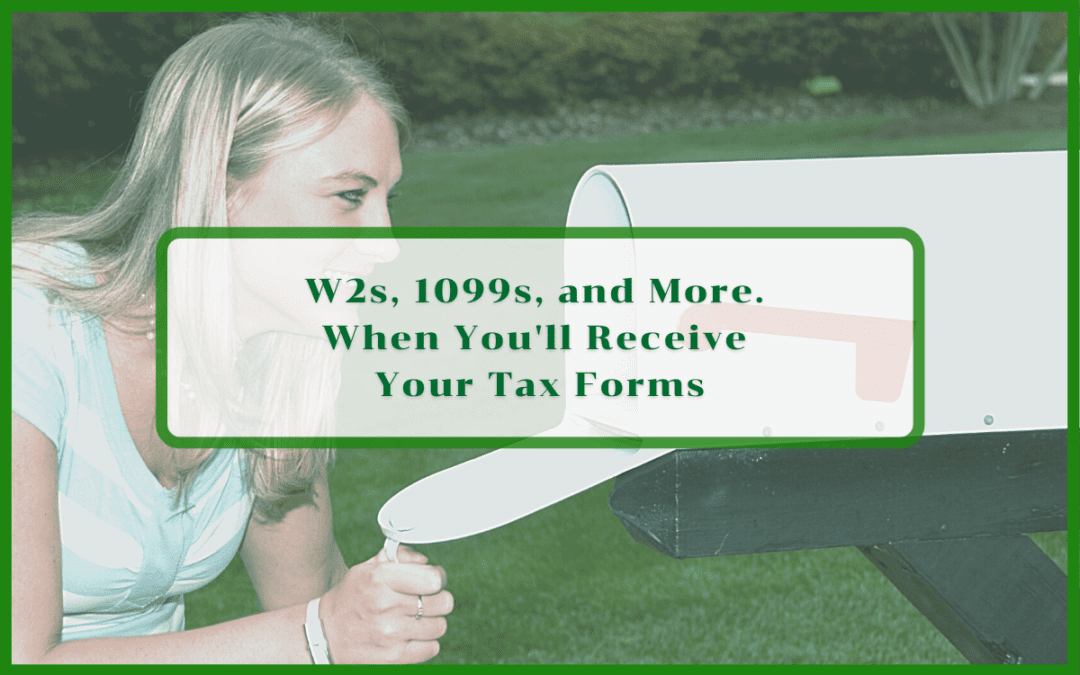The countdown has begun for those eager to get a jump on filing their taxes! But just when will all those tax forms hit your mailbox or inbox?
There are numerous tax forms you may receive each year including, but not limited to:
- Income:
- W-2s, Wage and Tax Statement
- 1099-INT, Interest Income
- 1099-DIV, Dividend Income
- 1099-B, Proceeds from Broker…Transactions
- 1099-NEC, Nonemployee Compensation (new for 2020)
- 1099-MISC, Miscellaneous Income
- 1099-G, Certain Government Payments (including unemployment & state refunds)
- 1099-R, Distributions From Pensions, Annuities, Retirement, etc.
- SSA-1099 or SSA-1042S, Social Security Benefit Statement
- Schedule K-1, Share of Income, Deductions, Credits from Partnerships, S-Corporations, or Trusts
- Deductions
- 1098, Mortgage Interest
- 1098-E, Student Loan Interest
- 1098-T, Tuition Statement
- 1095 Health Insurance Forms
- 1099-SA, Distributions From an HSA, Archer MSA, etc
Phew, that’s a lot of tax forms. Thankfully, many of us only have a few documents to look out for. However, with forms coming from multiple places, it’s helpful to know when you should start keeping an eye out for them.
W2s & 1099s Tax Forms Due to Recipients (You)
Income reporting is the bulk of our list, and the IRS likes consistency. Most of the forms are due to recipients by February 1, 2021. The due date is January 31 every year. This year the 31st falls on a Sunday, giving companies an extra day to pop them in the mail.
You may start inquiring where your forms are if you have not received them within 5-7 business days after the due date. This leaves some wiggle room for delivery time if the forms were mailed on the due date.
Tax Forms Due AFTER January 31
With most forms due to recipients by January 31, it’s faster to highlight common tax forms that make you wait a tad longer.
The Common Tax Forms
Two frequently received forms may have you eagerly waiting for that final piece of information to finish off your return.
Form 1099-B, Proceeds From Broker and Barter Exchange Transactions
This first form has a set due date. Form 1099-B, Proceeds From Broker and Barter Exchange Transactions, is due to recipients on February 15. This form provides information on all the transactions made within your brokerage account(s). It helps prepare your return by providing the details needed to determine the gain or loss associated with those transactions.
This information is usually more voluminous, depending on the account’s activity. It is more data to pull together and standardize. You may find that your broker proves this information in a consolidated 1099 statement that includes your 1099-INT, 1099-DIV, 1099-OID, and 1099-B.
NOTE: Reporting entities who provide a consolidated reporting statement for the account’s activity have until February 15 to issue the full statement. This keeps all the information in one place, reducing the possibility of filing before you’ve received all possible forms related to an account.
This is why investment accounts are one of the final items missing from checklists.
Schedule K-1
Another form that frequently holds up the show is Schedule K-1 (Sch K-1), Share of Income, Deductions, Credits, etc. This can be tricky to predict depending on your involvement with the company providing the form. Partnerships, S-Corps use Sch K-1, and Estates, to report the owner’s portion of…well… income, deductions, credits, and anything else flowing through to the owner.
From the partners with less than 1% of huge partnerships to the full 100% beneficiaries of trusts, every owner receives a Schedule K-1 that needs to be included in their income tax returns. The K-1 is generated once the entity files its income tax return. This means that until that return is completed and filed, there is no Sch K-1.
We can give you some hard and fast dates that returns themselves are due. These apply to entities with a December 31 yearend.
Partnerships (Form 1065) – due March 15 or extended to September 15
S-Corps (Form 1120S) – due March 15 or extended to September 15
Estates (Form 1042) – due April 15 or extended to October 15
The best bet? Check with the company or estate executor to estimate when they anticipate the returns will be completed.
The Rare Ones
Just for fun, here are some less common or hyper-specific forms that may also be received after January 31.
Don’t fret that the 5498s will show up after Tax Day, April 15. These forms are informational only. They help your tax preparer keep track of important information, but they are not required to file your return.
Conclusion
Once you’ve nailed down your tax forms, we’ll help you convert that data into a tax return. Tax Time CPAs will take the guesswork out of filing for all the deductions and credits you’re entitled to.
We’re ready to answer your questions about frequently changing tax legislation. This is an area of anxiety for many people. We’ll review your return with you so you’re comfortable when it is time to e-file it.
Contact us today to schedule an appointment.

